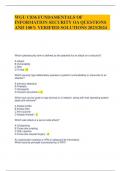Summary
Media, Time and Space - a schematic summary of all lectures, movies and readings (8,7 for final exam!!)
- Course
- Institution
In a schematic way – rather than a lineair order – the lectures, movies and readings of Media, Time and Space are summarised (+ some personal thoughts and summary conclusions). The schematic form helps to see and understand links between different texts more quickly. For me, this was very helpf...
[Show more]












